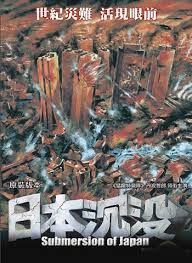
During the history of the Earth the continents have shifted due to the movement of the Earth’s tectonic plates. Japan is lodged among four major plates. They are the Pacific, the North American, the Eurasian and the Filipino Plates. Add to that various troughs, volcanoes and the Japan Trench and it’s easy to see that Japan’s solid ground is not so solid. In addition to Japan’s precarious position is the fact that the population of Japan in 1973 is somewhere around 108 million, all clustered on the coast, plains and valleys. The islands are subject to earthquakes, tsunamis, and typhoons. Japan also has over 100 active volcanoes.
When a small uninhabited island sinks, a team is assembled to check it out. Earth physicist Dr. Tadokoro (Keiju Kobayashi), with the assistance of Onodera Toshio (Hiroshi Fujioka), take the small submersible, the Wadatsumi I, to the ocean floor to check things out. Unable to determine what caused the island to sink the team decides to go down into the Japan Trench for a better idea of what’s happening.
The next day they take the Wadatsumi I down into the trench. Inside they hit an underwater current. At the bottom of the trench they see some strange ripples in the ocean floor. They follow the trench and find unusual turbulence. Something is going on in the trench that could affect all of Japan. Dr. Tadokoro wants to do more research in the trench to figure out exactly what is going on there but the Wadatsumi I is assigned to do other research for at least a year. Dr. Tadokoro is stymied until he can get more data. Soon after, Japan experiences a volcano eruption, an earthquake and a tsunami.
Prime Minister Yamamoto (Tetsuro Tamba) meets with Japanese officials to discuss the damage from the current disasters. Tadokoro warns that greater disasters are ahead. His warnings are ignored and he is written off as a crackpot. Tadokoro is approached by a young woman who brings him to see her uncle, Mr. Watari (Shogo Shimada). Watari is a man who has money and position. As such he has power. He believes Tadokoro’s claims that there is something much more sinister going on other than some localized disasters. Watari funds a project to discover exactly what is going on. Onodera quits his job with the submarine company and joins Dr. Tadokoro’s team.
After researching the trench and more disasters Tadokoro discovers that the Japanese Islands are sinking. Dr. Tadokoro informs the Prime Minister of his results. With Tadokoro’s revelation comes the next phase of the problem. How to get as many people as possible off the islands and emigrated to other countries to save their lives.
“Japan Sinks” AKA “Tidal Wave” AKA “Submersion of Japan” was released in 1973 and was directed by Shiro Moritani. It is a Japanese disaster movie by TOHO and was based on the 1973 novel “Japan Sinks” by Sakyo Komatsu.
Roger Corman bought the U.S. rights to the film for his New World Pictures. He cut out big chunks and added new scenes directed by Andrew Meyer. He got Lorne Greene to star in the new sequences as an ambassador at the United Nations. Roger released the cut and paste as “Tidal Wave” in 1975. The American version also added additional cast members such as Rhonda Leigh Hopkins, John Fukioka, Marvin Miller, Susan Sennett, Ralph James, Phil Roth, Cliff Pellow, and Joe Dante. New World Pictures also released the original Japanese film with subtitles but called it “Submersion of Japan”. This review is on the uncut subtitled version.
Japanese filmmakers are quite good and experienced at making disaster style films. There isn’t a part of Tokyo that hasn’t been stomped on, fire breathed on or exploded by any number of giant monsters or aliens. Their expertise in miniatures added with some cool actual footage of volcano lava flows adds some real and realistic scenes to the film. The movie is long, however, and much of it is explaining the whole “how to sink an Archipelago” tutorial and how to convince everyone the truth of what is happening in front of their face.
There are a few subplots in the film but not as many as you see in American disaster films. The movie itself may seem a little slow going at times but in addition to delivering a good disaster it also touches on the question: What would happen to this history and philosophy of an entire culture should it’s people have to become assimilated into every other culture in the world? Especially one that takes such emotional and religious pride in its traditions and customs.
Special effects director Teruyoshi Nakano mixed alcohol with water to make the tsunami effects more believable. Nakano said that the effects team became intoxicated as a result.
For the most part the film was good. There are some slow spots and it’s a little on the talky side but the special effects make up for it. If you are interested in watching “Japan Sinks”, and don’t speak Japanese, watch the uncut subtitled version. Stay away from Roger’s cut and paste.
English dubbed
Movie Tidal Wave

